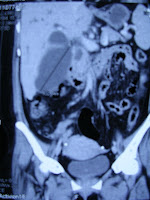PENGARUH TACE ATAU TACI PADA PENDERITA HEPATOCELLULAR CARCINOMA DENGAN GANGGUAN IMUN SISTEM (diskusi 10/08/2010)
1. Pendahuluan
Hepatocelluler carcinoma (HCC) merupakan penyakit kanker terlima terbanyak di dunia, mempunyai prognosis yang buruk sebagai tumor hepar yang maligant. Pada U.S. pasien dengan sirosis oleh karena infeksi kronik hepatitis B atau C, alkoholik dan hemocromatosis mempunyai risiko mendapatkan HCC. Dengan kombinasi studi imaging (Ultrasonography, CT dan MRI) dan elevasi level darah dari alfa-fetoprotein (AFP) menjadi lebih efektif dalam diagnosis. HCC yang resectable (biasanya kecil) dengan fungsi hati yang baik ditindaki dengan reseksi bedah namum yang unresectable biasanya ditindaki dengan TACI (transarterial chemo-infusion) atau TACE (transarterial chemo-embolisasi) sesuai prosedur inklusi maupun eksklusi .
2. Faktor risiko :
a. Hepatitis B atau Hepatitis C
b. Alkohol
c. Alfatoxin B1
d. Drug, medication dan chemical
e. Hemocromatosis
f. Cirrhrosis
3. Pemeriksaan Diagnostik HCC
Sel-sel HCC biasanya memproduksi hormon yg tersebar ke sistem tubuh kemudian memperlihatkan test darah abnormal berupa ;
• High red blood count (erytrocytosis)
• Low blood sugar (hypoglicemia)
• High blood calcium (hypercalcemia)
Alfa feto protein (AFP) mempunyai sensitivitas 60 % dalam menentukan HCC dan 40 % kelainan HCC memperlihatkan nilai normal. Nilai AFP lebih dari 500 ng/4µL dinyatakan sangat mendukung sebagai HCC. AFP yang berkurang berkolerasi dengan ukuran HCC yang juga mengecil sehingga abnormal AFP pada kelainan HCC dapat menjadi marker respon tindakan.
Imaging Study dapat memperlihatkan ukuran, jumlah, keterlibatan pembuluh darah dan penyebaran extrahepatika .
Evaluasi sel-sel hormonal HCC, Alfafetoprotein dan studi imaging pre maupun post tindakan TACE atau TACI dapat disimpulkan adanya komplit atau parsial respon , tidak ada perubahan, atau progressive disease.
4. Tindakan TACI atau TACE penderita HCC
Tindakan TACI atau TACE sebagai terapi pilihan paliatif. TACI arteri hepatika adalah memberikan dosis tinggi agen kemoterapi langsung ke hepar melalui feeding arteri tumor hepar dan mengurangi komplikasi lokal dari infusi arteri hepatika dengan drug delivery sistem seperti lipiodol, mikrokapsul dan bentuk mikrosphere. TACE arteri hepatika yaitu disamping memberikan agen kemoterapi langsung keorgan target juga dilakukan tindakan embolisasi. Tindakan ini lebih menguntungkan dibanding ligasi arteri hepatika karena dapat menimbulkan oklusi perifer serta mengurangi pengembangan sirkulasi kollateral. Kemoembolisasi merupakan suatu kombinasi simultan intraarterial kemoterapi dan embolisasi perifer pada suplai arteri ke tumor dan Gelfoam partikel dan campuran lipiodol dengan sejumlah agen khemoterapeutik seperti mitomicin C, doxorubicin dan cisplatin menjadi campuran yang sekarang luas digunakan utk kemoembolisasi arteri hepatika.
Yamada dkk melaporkan 120 pasien dgn HCC ditindaki dgn TAE menggunakan Gelfoam dan mitomicin C atau doxorubicin • 1 th jumlah rata-rata survive 44%• 2 th jumlah rata-rata survive 29%• 3 th jumlah rata-rata survive 15%
Kriteria inklusi tindakan kemoembolisasi ;
• Tumor responsive terhadap kemoembolisasi• Tumor unresectable• Vena portal paten • Fungsi liver dalam batas normal (normal level alkali fosfatase dan aspartat transaminase)• Level serum bilirubin <2>
Kriteria eksklusi tindakan kemoembolisasi ;
• Hepatic encephalopathy • Clinically apparent Jaundice • Oklusi vena portal • Hepatofugal portal vein flow • Extrahepatik tumor • Ruptur liver atau penetrasi tumor pada kapsul liver • Fungsi liver yg buruk (coagulopathy yg tdk dpt dikoreksi dgn vitamin K, level lactat dehidrogenase lebih three time institusional upper limit dari normal, elevasi alkaline fosfatase • Serum bilirubin level lebih dari > 5 mg/dl• Obstruksi biliary• Serum kreatinin level > 2 mg /dl• Hb Level <>
Note : (albumin level <> 2 mg/dL tetapi kurang dari 5 mg/dL dan coagulopathy dapat dikoreksi dgn vit. K, jika factor tersebut terjadi kombinasi maka risiko gagal hepar dapat tidak disetujui
Prosedur umum tindakan TACI atau TACE
Intravenous hydration
Propilaktik antibiotik
Premedication (analgesik, sedatif dan anti emetik)
Selektif arterial chemoembolisasi (mixture 10 ml iopamidol, 20 ml ethiodized oil and cytotoxic agent)
HCCàChemoterapi agent doxorubicin 60 mg
Injection should be slow with continuous fluoroscopic monitoring to ensure that is no reflux of chemoembolization material
Setelah Chemoembolisasi diberikan medikasi rutin (furasemide, hydromorphone hydrocloride, acetaminofen, prochlorperazine maleat, famotidine, lactulose)
AUTOIMMUNE DISEASE
Autoimmune chronic hepatitis terjadi 5 % dari semua penyakit hepar merupakan Inflamasi proggresive hati yang memperlihatkan abnormalitas sistem immune tubuh dan berhubungan produksi antibodi (globulin) sehingga menimbulkan kerusakan dari mekanisme immunoregulator. Keadaan ini dapat diperlihatkan;
Level transaminase AST dan ALT meningkat penderita kelihatan kolestatik
Peninggian level globulin atau antibody (>5 gm/dl) (Quantitative immune globulins can be helpful in making the diagnosis of autoimmune hepatitis)
Positive auto-antibody
Multi-system disease (thyroid, arthritis, other organs)
HLA A1,B8,DR3,DW3
TERAPI
Prednisolon 30-40 mg/harià respon terlihatàturunkan dosis
Standar dosis Prednisolon 10-15 mg/hari
Dosis rendah prednisolon Kombinasi azathioprine 50 mg/hari
Referensi :
01. Gates J et al. Chemoembolization of hepatic neoplasma : safety complication, and when to RadioGraphics 1999; 19:399–414
02. O Nawawi et al. Transarterial embolisation of hepatocellular carcinoma with doxorubicin-eluting beads: single centre early experience. Biomed Imaging Interv J 2010; 6(1):e7









